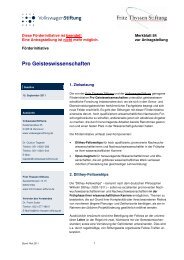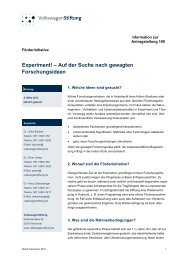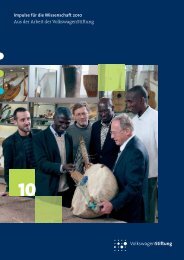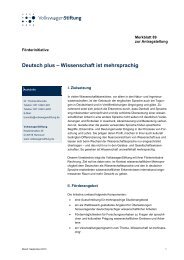Funding
Funding
Funding
You also want an ePaper? Increase the reach of your titles
YUMPU automatically turns print PDFs into web optimized ePapers that Google loves.
Avantgarde – Multiplied by Four<br />
Salamanders, icefish, crows and fruitflies provide<br />
young researchers with new insights into evolution.<br />
In the framework of its funding initiative “Evolutionary Biology”<br />
the Volkswagen Foundation is providing funds for postgraduate and<br />
postdoc positions. Four of the scholarship holders – representing some<br />
of the many facets of evolutionary research – are introduced here:<br />
They go into the woods at night, explore the freezing Antarctic, climb<br />
trees, and stuff tiny flies down plastic tubes.<br />
Raindrops fall from the trees, it is quiet and already dark when Ralf Hendrix<br />
enters Kottenforst forest: A good night for fire salamanders. It is on nights<br />
like these in the wooded area between Bonn and Meckenheim that the animals<br />
venture out of their hiding places in their dozens, easily seen crossing<br />
the forest tracks on their hunt for food. All the evolutionary biologist from<br />
Bonn has to do is to pick them up. He is researching the emergence of new<br />
species – and these little black and yellow amphibians permit him a direct<br />
insight into the fascination of evolution.<br />
For the fire salamanders of Kottenforst are actually going through the process<br />
of diverging into two different types: one line releases its larvae into running<br />
waters, whilst the other releases them into stagnant pools that regularly dry<br />
out. The two groups already exhibit differences in their genetic material, even<br />
though they only appeared in Kottenforst forest a few thousand years ago. A<br />
stroke of luck for Hendrix: “This is the first time we’re able to witness speciation<br />
at first hand without having to rely on examining already diverged species in<br />
order to reconstruct the process of speciation.” With his project the scientist<br />
from Bonn is breaking completely new ground. For traditional concepts of<br />
continental speciation require long-term geographical isolation of two groups<br />
for them to diverge into two distinct species.<br />
The fire salamanders near Bonn however, are diverging into two species<br />
even though they inhabit the same woodland, cross the same forest tracks,<br />
are active at the same time, and eat the same snails. That is why Hendrix is<br />
cataloguing their genes by taking tissue samples from toes; he implants the<br />
animals with small radio tracking devices in order to trace their movements;<br />
he collects their larvae and keeps meticulous record of where he encounters<br />
which species. Ralph Hendrix spends his nights in the forest because he is<br />
<strong>Funding</strong> initiative<br />
“Evolutionary Biology”<br />
– see page 75<br />
Ralph Hendrix with a fire salamander at night<br />
in the woods near Bonn: during the scholarship<br />
period he will write a dissertation on his<br />
black and yellow darlings.<br />
Crossing Borders 2010 47
















